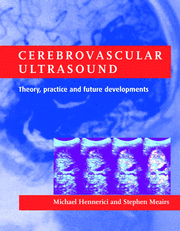Book contents
- Frontmatter
- Dedication
- Contents
- List of contributors
- Preface
- PART I ULTRASOUND PHYSICS, TECHNOLOGY AND HEMODYNAMICS
- PART II CLINICAL CEREBROVASCULAR ULTRASOUND
- PART III NEW AND FUTURE DEVELOPMENTS
- 25 Functional Doppler testing
- 26 Multigate emboli detection
- 27 Three- and four-dimensional cerebrovascular ultrasonography
- 28 Ultrasound contrast imaging
- 29 Ultrasonic thrombolysis
- Index
29 - Ultrasonic thrombolysis
from PART III - NEW AND FUTURE DEVELOPMENTS
Published online by Cambridge University Press: 05 July 2014
- Frontmatter
- Dedication
- Contents
- List of contributors
- Preface
- PART I ULTRASOUND PHYSICS, TECHNOLOGY AND HEMODYNAMICS
- PART II CLINICAL CEREBROVASCULAR ULTRASOUND
- PART III NEW AND FUTURE DEVELOPMENTS
- 25 Functional Doppler testing
- 26 Multigate emboli detection
- 27 Three- and four-dimensional cerebrovascular ultrasonography
- 28 Ultrasound contrast imaging
- 29 Ultrasonic thrombolysis
- Index
Summary
Implications of therapeutic ultrasound in cerebrovascular diseases
The treatment of acute stroke has advanced almost as dramatically since the 1980s as has the application of diagnostic ultrasound for cerebrovascular disease with routine use of duplex ultrasonography and evolution to 6 DOF ultrasound as discussed elsewhere in this book. Previously, stroke treatment was limited to supportive measures (Marshall & Mohr, 1993) and early secondary stroke prevention (Antiplatelet Trialists Collaboration, 1988; CAPRIE Steering Committee, 1996; Hass et al., 1989), but therapy to increase vascular perfusion acutely began in 1988 (Del Zoppo et al., 1988) and advanced with the use of intravenous rt-PA within 3 hours of symptom onset (Hacke et al., 1995; National Institute of Neurological Disorders and Stroke, rt-PA Stroke Study Group, 1995). Because of the sensitivity of brain tissue to ischemia, successful clinical outcome depends utmost on rapid recanalization of the occluded vessel (Bozzao et al., 1989). Spontaneous recanalization occurs in 15–20% of patients within the first 24 hours (Mori et al., 1992), and this rate may increase to 34–47% by intravenous administration and up to 90% by local intra-arterial administration of thrombolytic agents rapidly after symptom onset (Mori et al., 1988). Although thrombolysis can be remarkably successful, the relatively low rate of recanalization after systemic administration of rt-PA (National Institute of Neurological Disorders and Stroke rt-PA Stroke Study Group, 1995; Mori et al., 1992) likely contributes to the modest clinical benefit, and these problems have stimulated additional investigations to accelerate clot lysis and also to make thrombolytic therapy more widely available.
- Type
- Chapter
- Information
- Cerebrovascular UltrasoundTheory, Practice and Future Developments, pp. 404 - 415Publisher: Cambridge University PressPrint publication year: 2001
- 5
- Cited by



